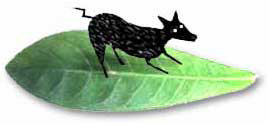
Philippine Herbs Used in Small Animal Practice
INTEGUMENTARY SYSTEM
| Herb | Indication | Preparation and Application | Active Ingredient | Precaution |
|
Sabila (Aloe barbadensis)*
|
Wounds, burns, abrasions, skin irritation | J/ S: Strip off outer skin and apply mesophyll on affected areas | Acemannan, allantoin, aloeemodin-anthran-C-glycoside, emonin, allantoin | Toxic when ingested (due to anthracoid present in the latex skin); not to be used in pregnant or lactating animals |
| Comfrey (Symphytum officinale) | Wounds, abscess, cuts | J/ S: Bruise the roots and immediately apply topically; or Pt/ Fo: leaves, overnight | Allantoin, tannin, mucous substances | Toxic when ingested (due to pyrrolizidin alkaloids and consolicine present) |
| Talong (Solanum melongena) | Wound, dermatophytes | J/ S: leaves, bid x7d | Alkaloid, tannin | Slight toxicity noted when ingested |
| Bayabas (Psidium guajava)* | Wounds | De/ S: leaves, and irrigate affected area tid x 3d | Tannin, saponin, volatile oil, fixed oil | |
|
Tobacco (Nicotiana tabacum)*
|
Surgical wound (from castration,
i.e.)
Tick infestation
|
Pt/
S: leaves mixed w/ paminta, betel nut and lime; T/ S: 75 g tobacco dust + 1 li H2O, filter in gauze, + 20 ml 70% isopropyl alcohol, apply bid x 3d; if moderate infestation, apply od x 7d more; Pw, I/ S: 75 gm leaves, soak in 1 li H2O (3d), filter, apply on infected areas, dip paws for 30 min and rinse off with tap water. |
Nicotine
|
Toxic when ingested
|
| Aroma (Acacia farnesiana) | Skin disease | Pt/ C: Use fresh leaves as rubbing agent | ||
| Atchuete (Bixa orellana) | Canine pyoderma, infected wounds | I/ S: Atchuete dye mixed with lime | Maslinic Acid (aka crataegolic acid) | Toxic when ingested |
| Tanglad (Cymbopogon citratus) | Tick infestation, Dermatophytes | J/ S:
leaves; or T/ S: leaves in ethanol at 1:3 (v/v) dilution |
Citral (an aldehyde in essential oil) | |
| Kakawate (Gliricidia sepium)* | Tick and flea infestation, Mange (S), Dermatophytes | De/ S: 500 gm leaves and young stalks in 1 li H2O apply within 24 hrs, weekly x 6 wks | Coumarin, tannin, anthraquinone, sulfur | |
| Manga (Mangifera indica) | Mange (S) | /S: Mix the gum resin with oil and apply topically | Saponin, tannin, peroxidase, sulfur | |
| Talisay (Terminalia catappa) | Mange (S) | J/ S: young leaves mixed with oil | Tannin, saponin, calcium oxalate, glycosieds | Toxic when ingested (due to punicalagin, a hydrolysable tannin, present) |
| Elefante (Heliotropium indicum), Atis (Anona squamosa) |
Mange (S) | De/ S: leaves | Alkaloid Alkaloid, tannin |
Toxic when ingested |
| Kuchai (Allium tuberosum) | Mange (S), Dermatophytes | De/ S: 500 gm leaves in 1 li H2O + 0.5 gm agar; after cooling, + 500 ml cooking oil, shake vigorously and apply to skin weekly x 3wks | Alliin, beta carotene | |
| Makabuhay (Tinospora crispa, T. rumphii) | Mange (S) | J/ S: vine, may + pounded coconut palm leaves, use as rubbing agent to affected areas | Berberine | |
| Akapulko (Cassia alata)* | Ear
mites, Psoroptes cuniculi, eczema Mange (D) |
De/
S: leaves, apply to the ears weekly x 4wks; Pt/ S: leaves |
Alkaloids, tannin, saponin, glycoside, calcium oxalate | Slightly toxic when ingested |
| Niyog (Cocos nucifera)* | Dermatophytes | /S: Oil | ||
| Gatas-gatasan (Euphorbia hirta) | Dermatophytes (Trichophyton mentagrophytes, T. simii) | De/ S: leaves | Alkaloids, tannin, sulfur, amygdalin | Ingenol ester (present in the latex) causes skin irritation & has tumor-promoting activity |
*Used by clients of the VTH, CVM, UPLB
Philippine Herbs Used in Small Animal Practice
Compiled by M. Leila Santiago-Flores, DVM
Introduction
Preparation and Application of Herbal Medicines
Integumentary System
Gastrointestinal System
Intestinal Parasitism
Respiratory System
Reproductive System
Urinary System
Circulatory System
Ophthalmic Disorders
Sources

Email: Leila Flores